Aquatic Invertebrates
Media

Species Types
Scientific Name
Lacunicambarus ludovicianus (syn. Cambarus ludovicianus)
Description
The painted devil crayfish is a burrowing lowland species. In Missouri, it is known from only a few locations in the Bootheel. Its overall color is olive green to blue, with reddish and cream markings.
Media
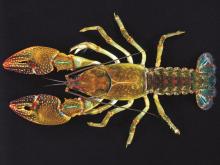
Species Types
Scientific Name
Lacunicambarus polychromatus (syn. Cambarus polychromatus)
Description
The paintedhand mudbug is a burrowing crayfish known in Missouri from only a few locations along the eastern border of the Bootheel. It is tan to olive green, and the abdominal segments and tail fan are trimmed with red. The pincers have red spots and red tips.
Media

Species Types
Scientific Name
Lacunicambarus aff. diogenes (syn. Cambarus diogenes)
Description
The powerfully built devil crayfish is usually a uniform olive or tan, without obvious blotches or spots. It digs underground burrows, often with mud chimneys, and has a wide distribution.
Media
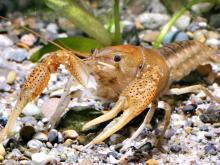
Species Types
Scientific Name
Procambarus acutus
Description
Adult White River crawfish are usually a deep burgundy red with a black V-shaped stripe on the abdomen. Juveniles are gray with dark spots scattered over the carapace. In Missouri, this species mostly occurs in the Bootheel and north along the Mississippi River.
Media
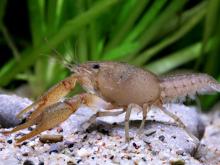
Species Types
Scientific Name
Procambarus viaeviridus
Description
Adult vernal crayfish are rusty red with a blackish wedge-shaped central stripe along the length of the abdomen. In Missouri, this species occurs only in our southeastern swamps and is usually only seen in February and March.
Media

Species Types
Scientific Name
Cambarellus shufeldtii
Description
Shufeldt’s dwarf crayfish is small, reddish brown to gray, with a paired series of dark, wavy stripes or dashes along the dorsal surface. In Missouri, it occurs in our southeastern lowlands and north along the Mississippi River floodplain.
Media
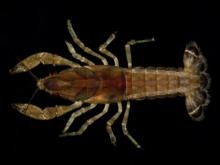
Species Types
Scientific Name
Faxonella clypeata
Description
The shield crayfish is small and tan, with a pattern of paired blackish dashes along the surface of the carapace and abdomen. The pincers are narrow, with short, abruptly tapering fingers. In Missouri it occurs only in our southeast counties.
Media
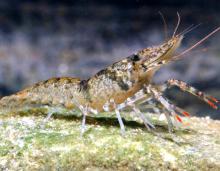
Species Types
Scientific Name
Faxonius lancifer (formerly Orconectes lancifer)
Description
The shrimp crayfish is medium-small, light reddish brown to gray, and thickly dusted with darker specks. Its noselike rostrum is unusually long, with the tip longer than the base, and the pincers are narrow and weak. It is found in the Bootheel.
Media
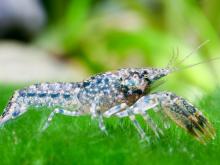
Species Types
Scientific Name
Cambarellus puer
Description
The Cajun dwarf crayfish is small, reddish brown to gray, with a paired series of dark, wavy stripes or dashes along the dorsal surface. In Missouri, it occurs in our southeastern lowlands.
Media

Species Types
Scientific Name
Faxonius immunis (formerly Orconectes immunis)
Description
The calico crayfish is rather plain: gray-green with a pale central zone along the middle of the carapace and abdomen. The pincers are orange-tipped, and in mature males are tinged with purple. It is usually only found in the northern half of the state.
See Also
About Aquatic Invertebrates in Missouri
Missouri's streams, lakes, and other aquatic habitats hold thousands of kinds of invertebrates — worms, freshwater mussels, snails, crayfish, insects, and other animals without backbones. These creatures are vital links in the aquatic food chain, and their presence and numbers tell us a lot about water quality.





















